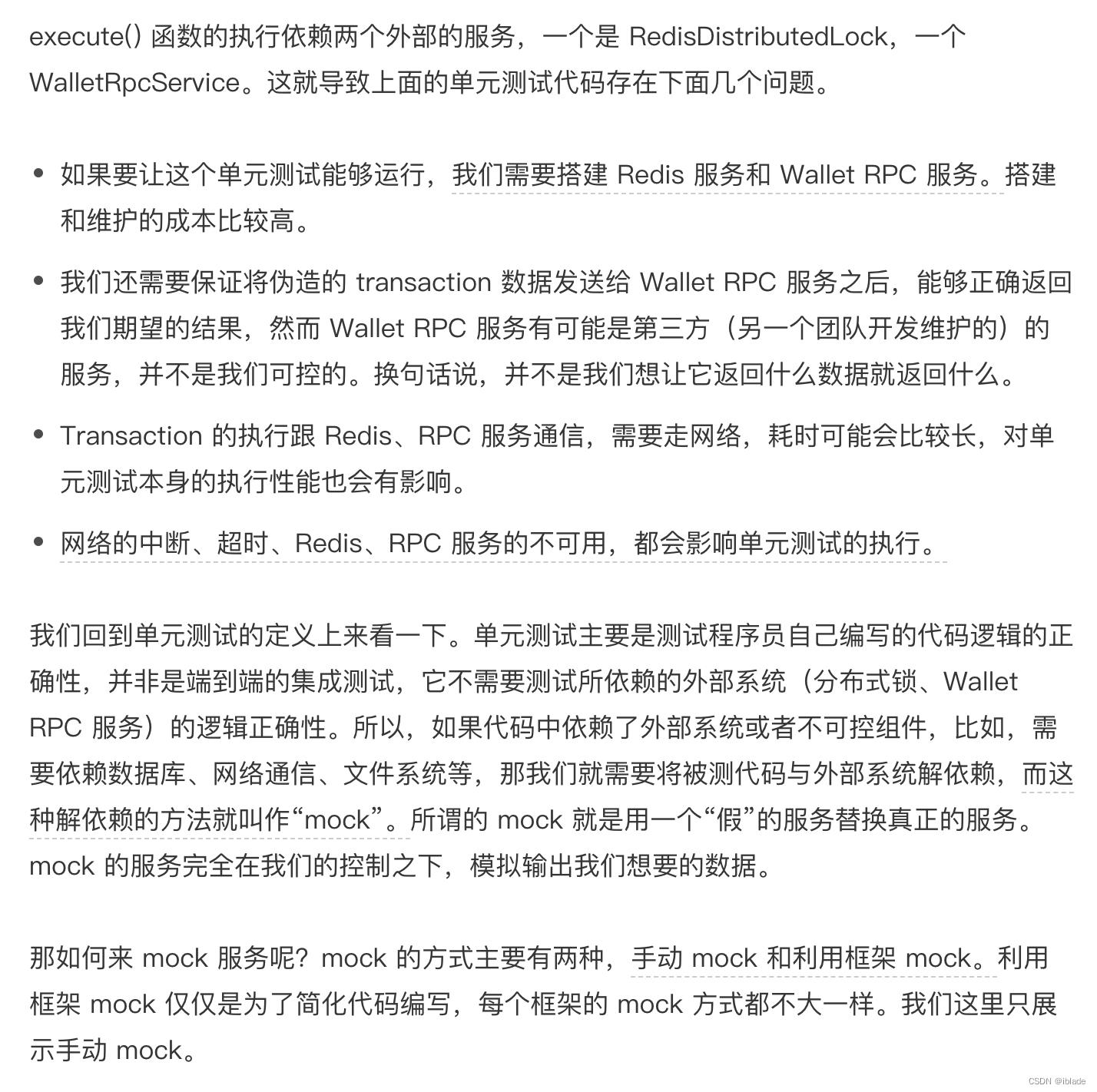设计模式之美——单元测试和代码可测性
Posted iblade
tags:
篇首语:本文由小常识网(cha138.com)小编为大家整理,主要介绍了设计模式之美——单元测试和代码可测性相关的知识,希望对你有一定的参考价值。
最可落地执行、最有效的保证重构不出错的手段应该就是单元测试(Unit Testing)。
什么是单元测试?
单元测试由研发工程师自己来编写,用来测试自己写的代码的正确性。我们常常将它跟集成测试放到一块来对比。单元测试相对于集成测试(Integration Testing)来说,测试的粒度更小一些。集成测试的测试对象是整个系统或者某个功能模块,比如测试用户注册、登录功能是否正常,是一种端到端(end to end)的测试。而单元测试的测试对象是类或者函数,用来测试一个类和函数是否都按照预期的逻辑执行。这是代码层级的测试。
单元测试除了能有效地为重构保驾护航之外,也是保证代码质量最有效的两个手段之一(另一个是 Code Review)。
写单元测试就是针对代码设计覆盖各种输入、异常、边界条件的测试用例,并将这些测试用例翻译成代码的过程。
在把测试用例翻译成代码的时候,我们可以利用单元测试框架,来简化测试代码的编写。比如,Java 中比较出名的单元测试框架有 Junit、TestNG、Spring Test 等。这些框架提供了通用的执行流程(比如执行测试用例的 TestCaseRunner)和工具类库(比如各种 Assert 判断函数)等。借助它们,我们在编写测试代码的时候,只需要关注测试用例本身的编写即可。

编写可测试代码案例实战
其中,Transaction 是经过我抽象简化之后的一个电商系统的交易类,用来记录每笔订单交易的情况。Transaction 类中的 execute() 函数负责执行转账操作,将钱从买家的钱包转到卖家的钱包中。真正的转账操作是通过调用 WalletRpcService RPC 服务来完成的。除此之外,代码中还涉及一个分布式锁 DistributedLock 单例类,用来避免 Transaction 并发执行,导致用户的钱被重复转出。
public class Transaction
private String id;
private Long buyerId;
private Long sellerId;
private Long productId;
private String orderId;
private Long createTimestamp;
private Double amount;
private STATUS status;
private String walletTransactionId;
// ...get() methods...
public Transaction(String preAssignedId, Long buyerId, Long sellerId, Long productId, String orderId)
if (preAssignedId != null && !preAssignedId.isEmpty())
this.id = preAssignedId;
else
this.id = IdGenerator.generateTransactionId();
if (!this.id.startWith("t_"))
this.id = "t_" + preAssignedId;
this.buyerId = buyerId;
this.sellerId = sellerId;
this.productId = productId;
this.orderId = orderId;
this.status = STATUS.TO_BE_EXECUTD;
this.createTimestamp = System.currentTimestamp();
public boolean execute() throws InvalidTransactionException
if ((buyerId == null || (sellerId == null || amount < 0.0)
throw new InvalidTransactionException(...);
if (status == STATUS.EXECUTED) return true;
boolean isLocked = false;
try
isLocked = RedisDistributedLock.getSingletonIntance().lockTransction(id);
if (!isLocked)
return false; // 锁定未成功,返回false,job兜底执行
if (status == STATUS.EXECUTED) return true; // double check
long executionInvokedTimestamp = System.currentTimestamp();
if (executionInvokedTimestamp - createdTimestap > 14days)
this.status = STATUS.EXPIRED;
return false;
WalletRpcService walletRpcService = new WalletRpcService();
String walletTransactionId = walletRpcService.moveMoney(id, buyerId, sellerId, amount);
if (walletTransactionId != null)
this.walletTransactionId = walletTransactionId;
this.status = STATUS.EXECUTED;
return true;
else
this.status = STATUS.FAILED;
return false;
finally
if (isLocked)
RedisDistributedLock.getSingletonIntance().unlockTransction(id);

测试用例 1 的代码实现:
public void testExecute()
Long buyerId = 123L;
Long sellerId = 234L;
Long productId = 345L;
Long orderId = 456L;
Transction transaction = new Transaction(null, buyerId, sellerId, productId, orderId);
boolean executedResult = transaction.execute();
assertTrue(executedResult);

我们通过继承 WalletRpcService 类,并且重写其中的 moveMoney() 函数的方式来实现 mock。具体的代码实现如下所示。通过 mock 的方式,我们可以让 moveMoney() 返回任意我们想要的数据,完全在我们的控制范围内,并且不需要真正进行网络通信。
public class MockWalletRpcServiceOne extends WalletRpcService
public String moveMoney(Long id, Long fromUserId, Long toUserId, Double amount)
return "123bac";
public class MockWalletRpcServiceTwo extends WalletRpcService
public String moveMoney(Long id, Long fromUserId, Long toUserId, Double amount)
return null;
现在我们再来看,如何用 MockWalletRpcServiceOne、MockWalletRpcServiceTwo 来替换代码中的真正的 WalletRpcService 呢?因为 WalletRpcService 是在 execute() 函数中通过 new 的方式创建的,我们无法动态地对其进行替换。也就是说,Transaction 类中的 execute() 方法的可测试性很差,需要通过重构来让其变得更容易测试。
该如何重构这段代码呢?在依赖反转中,我们讲到,依赖注入是实现代码可测试性的最有效的手段。我们可以应用依赖注入,将 WalletRpcService 对象的创建反转给上层逻辑,在外部创建好之后,再注入到 Transaction 类中。
依赖注入是实现代码可测试性的最有效的手段:通过DI实现反转,将对象的创建交给业务调用方,这样就可以随意控制输出的结果,从而达到"mock"数据的目的,这样的思路太赞了。。。(补充下:不存在外部依赖的类对象可以直接通过new来创建)
重构之后的 Transaction 类的代码如下所示:
public class Transaction
//...
// 添加一个成员变量及其set方法
private WalletRpcService walletRpcService;
public void setWalletRpcService(WalletRpcService walletRpcService)
this.walletRpcService = walletRpcService;
// ...
public boolean execute()
// ...
// 删除下面这一行代码
// WalletRpcService walletRpcService = new WalletRpcService();
// ...
现在,我们就可以在单元测试中,非常容易地将 WalletRpcService 替换成 MockWalletRpcServiceOne 或 WalletRpcServiceTwo 了。重构之后的代码对应的单元测试如下所示:
public void testExecute()
Long buyerId = 123L;
Long sellerId = 234L;
Long productId = 345L;
Long orderId = 456L;
Transction transaction = new Transaction(null, buyerId, sellerId, productId, orderId);
// 使用mock对象来替代真正的RPC服务
transaction.setWalletRpcService(new MockWalletRpcServiceOne()):
boolean executedResult = transaction.execute();
assertTrue(executedResult);
assertEquals(STATUS.EXECUTED, transaction.getStatus());
WalletRpcService 的 mock 和替换问题解决了,我们再来看 RedisDistributedLock。它的 mock 和替换要复杂一些,主要是因为 RedisDistributedLock 是一个单例类。单例相当于一个全局变量,我们无法 mock(无法继承和重写方法),也无法通过依赖注入的方式来替换。
如果 RedisDistributedLock 是我们自己维护的,可以自由修改、重构,那我们可以将其改为非单例的模式,或者定义一个接口,比如 IDistributedLock,让 RedisDistributedLock 实现这个接口。这样我们就可以像前面 WalletRpcService 的替换方式那样,替换 RedisDistributedLock 为 MockRedisDistributedLock 了。但如果 RedisDistributedLock 不是我们维护的,我们无权去修改这部分代码,这个时候该怎么办呢?
我们可以对 transaction 上锁这部分逻辑重新封装一下。具体代码实现如下所示:
public class TransactionLock
public boolean lock(String id)
return RedisDistributedLock.getSingletonIntance().lockTransction(id);
public void unlock()
RedisDistributedLock.getSingletonIntance().unlockTransction(id);
public class Transaction
//...
private TransactionLock lock;
public void setTransactionLock(TransactionLock lock)
this.lock = lock;
public boolean execute()
//...
try
isLocked = lock.lock();
//...
finally
if (isLocked)
lock.unlock();
//...
这样,我们就能在单元测试代码中隔离真正的 RedisDistributedLock 分布式锁这部分逻辑了。
public void testExecute()
Long buyerId = 123L;
Long sellerId = 234L;
Long productId = 345L;
Long orderId = 456L;
TransactionLock mockLock = new TransactionLock()
public boolean lock(String id)
return true;
public void unlock()
;
Transction transaction = new Transaction(null, buyerId, sellerId, productId, orderId);
transaction.setWalletRpcService(new MockWalletRpcServiceOne());
transaction.setTransactionLock(mockLock);
boolean executedResult = transaction.execute();
assertTrue(executedResult);
assertEquals(STATUS.EXECUTED, transaction.getStatus());
现在,我们再来看测试用例 3:交易已过期(createTimestamp 超过 14 天),交易状态设置为 EXPIRED,返回 false。
public void testExecute_with_TransactionIsExpired()
Long buyerId = 123L;
Long sellerId = 234L;
Long productId = 345L;
Long orderId = 456L;
Transction transaction = new Transaction(null, buyerId, sellerId, productId, orderId);
transaction.setCreatedTimestamp(System.currentTimestamp() - 14days);
boolean actualResult = transaction.execute();
assertFalse(actualResult);
assertEquals(STATUS.EXPIRED, transaction.getStatus());
上面的代码看似没有任何问题。我们将 transaction 的创建时间 createdTimestamp 设置为 14 天前,也就是说,当单元测试代码运行的时候,transaction 一定是处于过期状态。但是,如果在 Transaction 类中,并没有暴露修改 createdTimestamp 成员变量的 set 方法(也就是没有定义 setCreatedTimestamp() 函数)呢?
你可能会说,如果没有 createTimestamp 的 set 方法,我就重新添加一个呗!实际上,这违反了类的封装特性。在 Transaction 类的设计中,createTimestamp 是在交易生成时(也就是构造函数中)自动获取的系统时间,本来就不应该人为地轻易修改,所以,暴露 createTimestamp 的 set 方法,虽然带来了灵活性,但也带来了不可控性。因为,我们无法控制使用者是否会调用 set 方法重设createTimestamp,而重设 createTimestamp 并非我们的预期行为。
那如果没有针对 createTimestamp 的 set 方法,那测试用例 3 又该如何实现呢?实际上,这是一类比较常见的问题,就是代码中包含跟“时间”有关的“未决行为”逻辑。我们一般的处理方式是将这种未决行为逻辑重新封装。针对 Transaction 类,我们只需要将交易是否过期的逻辑,封装到 isExpired() 函数中即可,具体的代码实现如下所示:
public class Transaction
protected boolean isExpired()
long executionInvokedTimestamp = System.currentTimestamp();
return executionInvokedTimestamp - createdTimestamp > 14days;
public boolean execute() throws InvalidTransactionException
//...
if (isExpired())
this.status = STATUS.EXPIRED;
return false;
//...
针对重构之后的代码,测试用例 3 的代码实现如下所示:
public void testExecute_with_TransactionIsExpired()
Long buyerId = 123L;
Long sellerId = 234L;
Long productId = 345L;
Long orderId = 456L;
Transction transaction = new Transaction(null, buyerId, sellerId, productId, orderId)
protected boolean isExpired()
return true;
;
boolean actualResult = transaction.execute();
assertFalse(actualResult);
assertEquals(STATUS.EXPIRED, transaction.getStatus());
通过重构,Transaction 代码的可测试性提高了。之前罗列的所有测试用例,现在我们都顺利实现了。不过,Transaction 类的构造函数的设计还有点不妥。
public Transaction(String preAssignedId, Long buyerId, Long sellerId, Long productId, String orderId)
if (preAssignedId != null && !preAssignedId.isEmpty())
this.id = preAssignedId;
else
this.id = IdGenerator.generateTransactionId();
if (!this.id.startWith("t_"))
this.id = "t_" + preAssignedId;
this.buyerId = buyerId;
this.sellerId = sellerId;
this.productId = productId;
this.orderId = orderId;
this.status = STATUS.TO_BE_EXECUTD;
this.createTimestamp = System.currentTimestamp();
我们发现,构造函数中并非只包含简单赋值操作。交易 id 的赋值逻辑稍微复杂。我们最好也要测试一下,以保证这部分逻辑的正确性。为了方便测试,我们可以把 id 赋值这部分逻辑单独抽象到一个函数中,具体的代码实现如下所示:
public Transaction(String preAssignedId, Long buyerId, Long sellerId, Long productId, String orderId)
//...
fillTransactionId(preAssignId);
//...
protected void fillTransactionId(String preAssignedId)
if (preAssignedId != null && !preAssignedId.isEmpty())
this.id = preAssignedId;
else
this.id = IdGenerator.generateTransactionId();
if (!this.id.startWith("t_"))
this.id = "t_" + preAssignedId;
Transaction 类中 isExpired() 函数就不用测试了吗?对于 isExpired() 函数,逻辑非常简单,肉眼就能判定是否有 bug,是可以不用写单元测试的。
其他常见的 Anti-Patterns
上面通过一个实战案例,讲解了如何利用依赖注入来提高代码的可测试性,以及编写单元测试中最复杂的一部分内容:如何通过 mock、二次封装等方式解依赖外部服务。现在,我们再来总结一下,有哪些典型的、常见的测试性不好的代码,也就是我们常说的 Anti-Patterns。
1. 未决行为
代码的输出是随机或者说不确定的,比如,跟时间、随机数有关的代码。
2. 全局变量
全局变量是一种面向过程的编程风格,有种种弊端。实际上,滥用全局变量也让编写单元测试变得困难。
RangeLimiter 表示一个[-5, 5]的区间,position 初始在 0 位置,move() 函数负责移动 position。其中,position 是一个静态全局变量。RangeLimiterTest 类是为其设计的单元测试。
public class RangeLimiter
private static AtomicInteger position = new AtomicInteger(0);
public static final int MAX_LIMIT = 5;
public static final int MIN_LIMIT = -5;
public boolean move(int delta)
int currentPos = position.addAndGet(delta);
boolean betweenRange = (currentPos <= MAX_LIMIT) && (currentPos >= MIN_LIMIT);
return betweenRange;
public class RangeLimiterTest
public void testMove_betweenRange()
RangeLimiter rangeLimiter = new RangeLimiter();
assertTrue(rangeLimiter.move(1));
assertTrue(rangeLimiter.move(3));
assertTrue(rangeLimiter.move(-5));
public void testMove_exceedRange()
RangeLimiter rangeLimiter = new RangeLimiter();
assertFalse(rangeLimiter.move(6));
上面的单元测试有可能会运行失败。假设单元测试框架顺序依次执行 testMove_betweenRange() 和 testMove_exceedRange() 两个测试用例。在第一个测试用例执行完成之后,position 的值变成了 -1;再执行第二个测试用例的时候,position 变成了 5,move() 函数返回 true,assertFalse 语句判定失败。所以,第二个测试用例运行失败。
当然,如果 RangeLimiter 类有暴露重设(reset)position 值的函数,我们可以在每次执行单元测试用例之前,把 position 重设为 0,这样就能解决刚刚的问题。
不过,每个单元测试框架执行单元测试用例的方式可能是不同的。有的是顺序执行,有的是并发执行。对于并发执行的情况,即便我们每次都把 position 重设为 0,也并不奏效。如果两个测试用例并发执行,第 16、17、18、23 这四行代码可能会交叉执行,影响到 move() 函数的执行结果。
以上是关于设计模式之美——单元测试和代码可测性的主要内容,如果未能解决你的问题,请参考以下文章